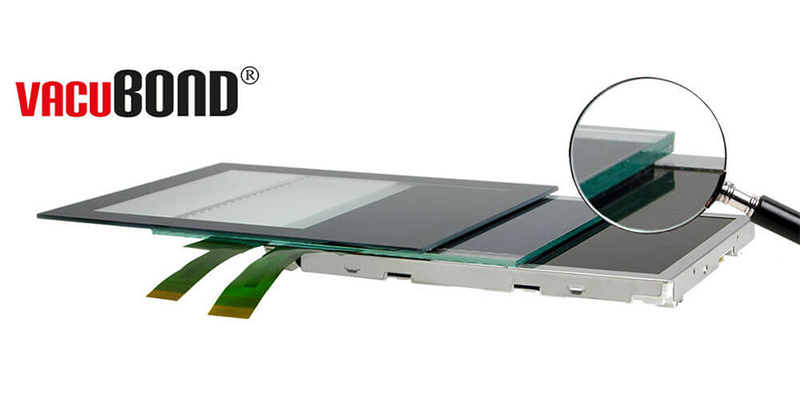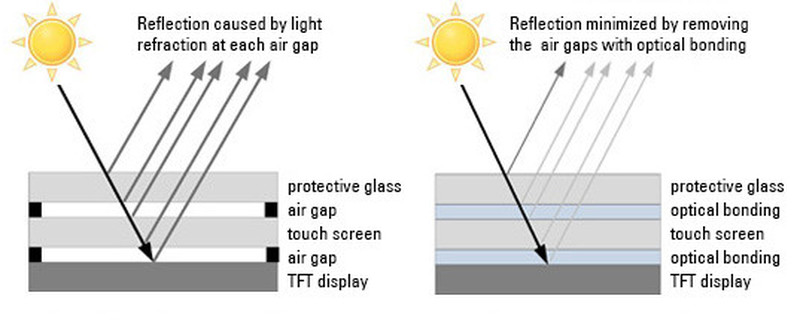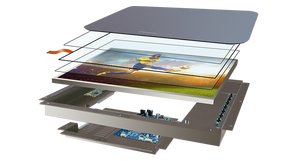Optical Bonding, which involves bonding a cover glass or touch screen to an LCD cell, enables us to laminate all kinds of cover glasses. We can eliminate air gaps by inserting an adhesive, such as silicone gel, epoxy or urethane between the cover glass and the LCD.
Here at FORTEC Switzerland, we use our VacuBond® process to achieve the best results, inserting a high-quality Opto a-Gel between the cover glass / touch screen and LCD.

Why choose FORTEC Switzerland for Optical Bonding?
Here at FORTEC Switzerland, we pride ourselves on offering the highest level of service and our Optical Bonding process is no exception. Our experts have years of experience when it comes to applying Optical Bonding to devices in-house.
Our fantastic facilities are at the heart of the entire process, ensuring that the service is carried out and completed to the highest possible standard and we are also able to provide a sample of the finished product so that you can see the quality firsthand.
With more than 15 years of experience within the industry, we are proud to offer an impressive service whilst we meet your individual, Optical Bonding and display requirements with ease.
How does the VacuBond® optical bonding process work?
Using the VacuBond®, various components are bonded together with the high-performance silicone Opto a-Gel in a clean room. The optical bonding fills the air gaps between the individual components and reduces the reflection of light on the surfaces by 99 percent! So the readability of our TFT displays is excellent, with perfect contrast and colour brilliance.
The displays also maintain this visibility and quality even when being used outdoors and in bright light.

Optical Bonding Downloads
Optical bonding clients tend to prefer the longer life PREMIUM industrial panels.
Please see this range is with 5 years longevity statements.
Why VacuBond®?
In this modern age, more and more manufacturers provide TFT displays with an integrated PCAP touch screen as standard. However, in many cases a special/custom front glass is needed for better protection or an improved design.
Our VacuBond optical bonding process provides an excellent solution and, following our recent install of two larger machines this year we can now bond TFT displays up to a size of 32”.
We can provide touch displays and custom protective glasses as required and optical bonding with zero optical defect production.
What are the benefits of Optical Bonding/VacuBond®?
- Increased vibration and shock resistance
- Increased Contrast
- No condensation or fogging
- Zero contamination (of dust and dirt)
- Improved heat dissipation (heat can dissipate through the front glass)
What can be optically bonded using the VacuBond®process?
- TFT displays up to a maximum size of 32”
- Cover glasses onto TFT displays with integrated PCAP touch
- PMMA/Acrylic glass
- All types of touch screens and/or protective glass
- The rear of the TFT cell to eliminate free air spaces
- Direct bonding into your housing/bezel
- Modern TFT displays without solid frame/housing

What types of display can be bonded?
When it comes to Optical Bonding, it is critical that both the front surface of the LDC and the rear surface of the filter are flat. That being said however, the majority of displays can be bonded. At FORTEC UK, we undertake a test that determines the adhesion angle of each material layer.
What are the different methods of Optical Bonding?
There are two different methods of Optical Bonding, the first being the more traditional. LOCA (Liquid Optically Clear Adhesive) or ‘wet bonding’ has long pioneered the process; however it is not without its problems. The only chance for rework is prior to the curing process and curing can be lengthy and time-consuming, also it is a labour-intensive process due to the requirement to create a ‘dam’ for the wet silicone.
'Dry bonding’ is the second process which was developed as a result of the high volume, high consistency requirements of tablet and smart phone bonding. This process refers to the vacuum application of a silicone sheet between the layers, which allows for multiple displays to be bonded quickly and simultaneously via a multi cavity Jig.
Which industries are most suited to Optical Bonding?
Optical Bonding lends itself perfectly to a range of different industries, typically those that require higher performing displays. Optical Bonding is suited to industries that tend to use rugged displays in high reliability environments or industries where displays need to be seen in high ambient light conditions. The process of Optical Bonding is particularly well suited and much more effective when applied to devices that operate outdoors or in heavily lighted environments.
Typically, Optical Bonding is used in and popular among the military, marine, medical, transportation and retail sectors.
Can the process of Optical Bonding be reversed?
Dry bonding can absoloutely be reversed. As there is no curing requirement for the VacuBond process, therefore dry bonding can be reversed throughout the life of the product, unlike traditional wet bonding.
Tempering/Pre-Aging Heating Cabinets
Our head office in Munich has special industrial heating cabinets and we can use this facility to provide a pre-aging/tempering service.
Modules up to a size of 21.5” can be exposed to temperatures between +30 and + 300°C. By doing this we can detect weak points and prevent future breakdowns of equipment.
We can undertake experiments over a number of days to your temperature requirements.
Optical Bonding Service
Through our head office FORTEC Integrated in Germering, we are able to offer our VacuBond® optical bonding service for any display, part of our range or not, up to a size of 32”.
Not only do we have the production facility in Germering, we also have an identical facility in our American subsidiary FORTEC USA. Thanks to further demand for our optical bonding service we have installed additional production facilities. One in Dysina/Pilsen in the Czech Republic and an extra in Ronkonkoma, NY.

















